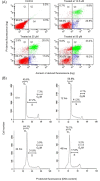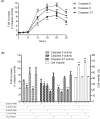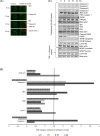Cycloart-24-ene-26-ol-3-one, a New Cycloartane Isolated from Leaves of Aglaia exima Triggers Tumour Necrosis Factor-Receptor 1-Mediated Caspase-Dependent Apoptosis in Colon Cancer Cell Line
- PMID: 27070314
- PMCID: PMC4829234
- DOI: 10.1371/journal.pone.0152652
Cycloart-24-ene-26-ol-3-one, a New Cycloartane Isolated from Leaves of Aglaia exima Triggers Tumour Necrosis Factor-Receptor 1-Mediated Caspase-Dependent Apoptosis in Colon Cancer Cell Line
Abstract
Plants in the Meliaceae family are known to possess interesting biological activities, such as antimalaral, antihypertensive and antitumour activities. Previously, our group reported the plant-derived compound cycloart-24-ene-26-ol-3-one isolated from the hexane extracts of Aglaia exima leaves, which shows cytotoxicity towards various cancer cell lines, in particular, colon cancer cell lines. In this report, we further demonstrate that cycloart-24-ene-26-ol-3-one, from here forth known as cycloartane, reduces the viability of the colon cancer cell lines HT-29 and CaCO-2 in a dose- and time-dependent manner. Further elucidation of the compound's mechanism showed that it binds to tumour necrosis factor-receptor 1 (TNF-R1) leading to the initiation of caspase-8 and, through the activation of Bid, in the activation of caspase-9. This activity causes a reduction in mitochondrial membrane potential (MMP) and the release of cytochrome-C. The activation of caspase-8 and -9 both act to commit the cancer cells to apoptosis through downstream caspase-3/7 activation, PARP cleavage and the lack of NFkB translocation into the nucleus. A molecular docking study showed that the cycloartane binds to the receptor through a hydrophobic interaction with cysteine-96 and hydrogen bonds with lysine-75 and -132. The results show that further development of the cycloartane as an anti-cancer drug is worthwhile.
Conflict of interest statement
Figures








Similar articles
-
Annona muricata leaves induce G₁ cell cycle arrest and apoptosis through mitochondria-mediated pathway in human HCT-116 and HT-29 colon cancer cells.J Ethnopharmacol. 2014 Oct 28;156:277-89. doi: 10.1016/j.jep.2014.08.011. Epub 2014 Sep 4. J Ethnopharmacol. 2014. PMID: 25195082
-
Triterpenes and steroids from the leaves of Aglaia exima (Meliaceae).Fitoterapia. 2012 Dec;83(8):1391-5. doi: 10.1016/j.fitote.2012.10.004. Epub 2012 Oct 23. Fitoterapia. 2012. PMID: 23098876
-
HUHS1015 Suppresses Colonic Cancer Growth by Inducing Necrosis and Apoptosis in Association with Mitochondrial Damage.Anticancer Res. 2016 Jan;36(1):39-48. Anticancer Res. 2016. PMID: 26722026
-
Potential of cyclopenta[b]benzofurans from Aglaia species in cancer chemotherapy.Anticancer Agents Med Chem. 2006 Jul;6(4):319-45. doi: 10.2174/187152006777698123. Anticancer Agents Med Chem. 2006. PMID: 16842234 Review.
-
Rocaglamide, silvestrol and structurally related bioactive compounds from Aglaia species.Nat Prod Rep. 2014 Jul;31(7):924-39. doi: 10.1039/c4np00006d. Epub 2014 May 2. Nat Prod Rep. 2014. PMID: 24788392 Free PMC article. Review.
Cited by
-
Current Status, Distribution, and Future Directions of Natural Products against Colorectal Cancer in Indonesia: A Systematic Review.Molecules. 2021 Aug 17;26(16):4984. doi: 10.3390/molecules26164984. Molecules. 2021. PMID: 34443572 Free PMC article.
-
Tricholoma matsutake Aqueous Extract Induces Hepatocellular Carcinoma Cell Apoptosis via Caspase-Dependent Mitochondrial Pathway.Biomed Res Int. 2016;2016:9014364. doi: 10.1155/2016/9014364. Epub 2016 Nov 28. Biomed Res Int. 2016. PMID: 28018916 Free PMC article.
-
Genistein induces apoptosis of colon cancer cells by reversal of epithelial-to-mesenchymal via a Notch1/NF-κB/slug/E-cadherin pathway.BMC Cancer. 2017 Dec 4;17(1):813. doi: 10.1186/s12885-017-3829-9. BMC Cancer. 2017. PMID: 29202800 Free PMC article.
-
Rapid Determination of Major Compounds in the Ethanol Extract of Geopropolis from Malaysian Stingless Bees, Heterotrigona itama, by UHPLC-Q-TOF/MS and NMR.Molecules. 2017 Nov 10;22(11):1935. doi: 10.3390/molecules22111935. Molecules. 2017. PMID: 29125569 Free PMC article.
-
Water-based propolis enhances 5-fluorouracil drug efficiency in gastric and colorectal cancer cells through cell stress response, anti-migratory, and apoptotic effects regardless of p53 status.Med Oncol. 2025 Aug 26;42(10):449. doi: 10.1007/s12032-025-03023-6. Med Oncol. 2025. PMID: 40858788
References
Publication types
MeSH terms
Substances
LinkOut - more resources
Full Text Sources
Other Literature Sources
Research Materials

